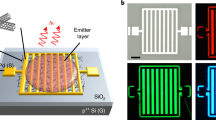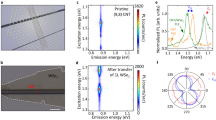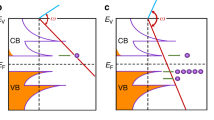Abstract
Electrically driven light emission from carbon nanotubes1,2,3,4,5,6,7,8 could be used in nanoscale lasers9 and single-photon sources10, and has therefore been the focus of much research. However, high electric fields and currents have either been necessary for electroluminescence4,5,6,7,8, or have been an undesired side effect2,3, leading to high power requirements and low efficiencies. Furthermore, electroluminescent linewidths have been broad enough to obscure the contributions of individual optical transitions. Here, we report electrically induced light emission from individual carbon nanotube p–n diodes. A new level of control over electrical carrier injection is achieved, reducing power dissipation by a factor of up to 1,000, and resulting in zero threshold current, negligible self-heating and high carrier-to-photon conversion efficiencies. Moreover, the electroluminescent spectra are significantly narrower (∼35 meV) than in previous studies1,2,3,4,5,6,7,8, allowing the identification of emission from free and localized excitons.
This is a preview of subscription content, access via your institution
Access options
Subscribe to this journal
Receive 12 print issues and online access
$259.00 per year
only $21.58 per issue
Buy this article
- Purchase on Springer Link
- Instant access to full article PDF
Prices may be subject to local taxes which are calculated during checkout




Similar content being viewed by others
References
Avouris, Ph., Freitag, M. & Perebeinos, V. Carbon-nanotube photonics and optoelectronics. Nature Photon. 2, 341–350 (2008).
Misewich, J. A. et al. Electrically induced optical emission from a carbon nanotube FET. Science 300, 783–786 (2003).
Freitag, M. et al. Hot carrier EL from a single carbon nanotube. Nano Lett. 4, 1063–1066 (2004).
Chen, J. et al. Bright infrared emission from electrically induced excitons in carbon nanotubes. Science 310, 1171–1174 (2005).
Marty, L. et al. Exciton formation and annihilation during 1D impact excitation of carbon nanotubes. Phys. Rev. Lett. 96, 136803 (2006).
Adam, E. et al. Electroluminescence from single-wall carbon nanotube network transistors. Nano Lett. 8, 2351–2355 (2008).
Mann, D. et al. Electrically driven thermal light emission from individual single-walled carbon nanotubes. Nature Nanotech. 2, 33–38 (2007).
Xie, L. et al. Electroluminescence from suspended and on-substrate metallic single-walled carbon nanotubes. Nano Lett. 9, 1747–1751 (2009).
Noda, S. Seeking the ultimate nanolaser. Science 314, 260–261 (2006).
Högele, A., Galland, C., Winger, M. & Imamoglu, A. Photon antibunching in the photoluminescence spectra of a single carbon nanotube. Phys. Rev. Lett. 100, 217401 (2008).
Lee, J. U., Gipp, P. P. & Heller, C. M. Carbon nanotube p–n junction diodes. Appl. Phys. Lett. 85, 145–147 (2004).
Jorio, A., Dresselhaus, M. S. & Dresselhaus, G. (eds) Carbon Nanotubes: Advanced Topics in the Synthesis, Structure, Properties and Applications (Springer, 2008).
Spataru, C. D., Ismail-Beigi, S., Capaz, R. B. & Louie, S. G. Theory and ab initio calculation of radiative lifetime of excitons in semiconducting carbon nanotubes. Phys. Rev. Lett. 95, 247402 (2005).
Perebeinos, V., Tersoff, T. & Avouris, Ph. Radiative lifetime of excitons in carbon nanotubes. Nano Lett. 5, 2495–2499 (2005).
Wang, F., Dukovic, G., Brus, L. E. & Heinz, T. F. Time-resolved fluorescence of carbon nanotubes and its implication for radiative lifetimes. Phys. Rev. Lett. 92, 177401 (2004).
Hagen, A. et al. Exponential decay lifetimes of excitons in individual single-walled carbon nanotubes. Phys. Rev. Lett. 95, 197401 (2005).
Perebeinos, V. & Avouris, Ph. Phonon and electronic nonradiative decay mechanisms of excitons in carbon nanotubes. Phys. Rev. Lett. 101, 057401 (2008).
Xia, F., Steiner, M., Lin, Y. & Avouris, Ph. A microcavity-controlled, current-driven, on-chip nanotube emitter at infrared wavelengths. Nature Nanotech. 3, 609–613 (2008).
Jorio, A. et al. Structural (n, m) determination of isolated single-wall carbon nanotubes by resonant Raman scattering. Phys. Rev. Lett. 86, 1118–1121 (2001).
Perebeinos, V., Tersoff, T. & Avouris, Ph. Scaling of excitons in carbon nanotubes. Phys. Rev. Lett. 92, 257402 (2004).
Harutyunyan, H. et al. Defect-induced photoluminescence from dark excitonic states in individual single-walled carbon nanotubes. Nano Lett. 9, 2010–2014 (2009).
Kiowski, O. et al. Direct observation of deep excitonic states in the photoluminescence spectra of single-walled carbon nanotubes. Phys. Rev. Lett. 99, 237402 (2007).
Ma, Y. et al. Femtosecond spectroscopy of optical excitations in single-walled carbon nanotubes: evidence for exciton–exciton annihilation. Phys. Rev. Lett. 94, 157402 (2005).
Wang, F. et al. Observation of rapid Auger recombination in optically excited semiconducting carbon nanotubes. Phys. Rev. B 70, 241403 (2004).
Tsyboulski, D. A. et al. Structure-dependent fluorescence efficiencies of individual single-walled carbon nanotubes. Nano Lett. 7, 3080–3085 (2007).
Wang, F., Wu, Y., Hybertsen, M. S. & Heinz, T. F. Auger recombination of excitons in one-dimensional systems. Phys. Rev. B 73, 245424 (2006).
Heinze, S., Radosavljevic, M., Tersoff, J. & Avouris Ph. Unexpected scaling of the performance of carbon nanotube Schottky-barrier transistors. Phys. Rev. B 68, 235418 (2003).
Perebeinos, V. & Avouris, Ph. Exciton ionization, Franz–Keldysh and Stark effects in carbon nanotubes. Nano Lett. 7, 609–613 (2007).
Yoshikawa, K., Matsunaga, R., Matsuda, K. & Kanemitsu, Y. Mechanism of exciton dephasing in a single carbon nanotube studied by photoluminescence spectroscopy. Appl. Phys. Lett. 94, 093109 (2009).
Lefebvre, J., Austing, D. G., Bond, J. & Finnie, P. Photoluminescence imaging of suspended single-walled carbon nanotubes. Nano Lett. 6, 1603–1608 (2006).
Acknowledgements
The authors would like to thank Z. Chen, M. Freitag, Y.-M. Lin, E. E. Mendez and F. Xia for helpful discussions, and B. A. Ek for technical assistance. T.M. acknowledges financial support by the Austrian Science Fund FWF (Erwin Schrödinger fellowship J2705-N16).
Author information
Authors and Affiliations
Contributions
T.M. and M.K. were responsible for the experimental work. All authors discussed the results and commented on the manuscript.
Corresponding authors
Supplementary information
Supplementary information
Supplementary information (PDF 1125 kb)
Rights and permissions
About this article
Cite this article
Mueller, T., Kinoshita, M., Steiner, M. et al. Efficient narrow-band light emission from a single carbon nanotube p–n diode. Nature Nanotech 5, 27–31 (2010). https://doi.org/10.1038/nnano.2009.319
Received:
Accepted:
Published:
Issue Date:
DOI: https://doi.org/10.1038/nnano.2009.319
This article is cited by
-
Carbon materials: The burgeoning promise in electronics
International Journal of Minerals, Metallurgy and Materials (2022)
-
Deterministic transfer of optical-quality carbon nanotubes for atomically defined technology
Nature Communications (2021)
-
Electrically-driven Yagi-Uda antennas for light
Nature Communications (2020)
-
Broadband electroluminescence from reverse breakdown in individual suspended carbon nanotube pn-junctions
Nano Research (2020)
-
Drain-engineered carbon-nanotube-film field-effect transistors with high performance and ultra-low current leakage
Nano Research (2020)



